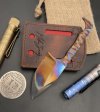Cobalt
Platinum Member
- Joined
- Dec 23, 1998
- Messages
- 17,837
We both had the same confusion. But in the end it is bark river that confused the issue. The blades are not and cannot be convex profile as designed. They are flat ground transitioned to a convex edge that is blended to the flat. Just a larger convex. Others do this as well.Zero Natlek you don't need to remove anything from the spine, just blend up to its level.
Here is diagram without your excessive matetial removal of the spine.


